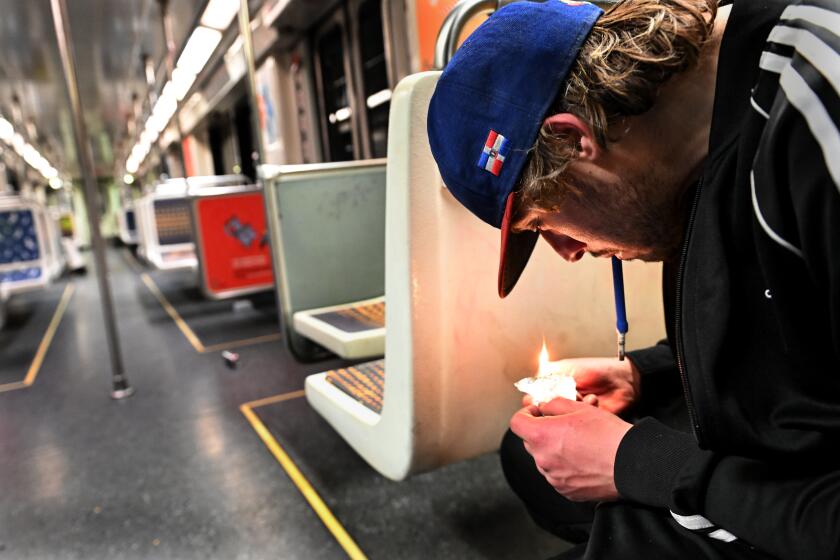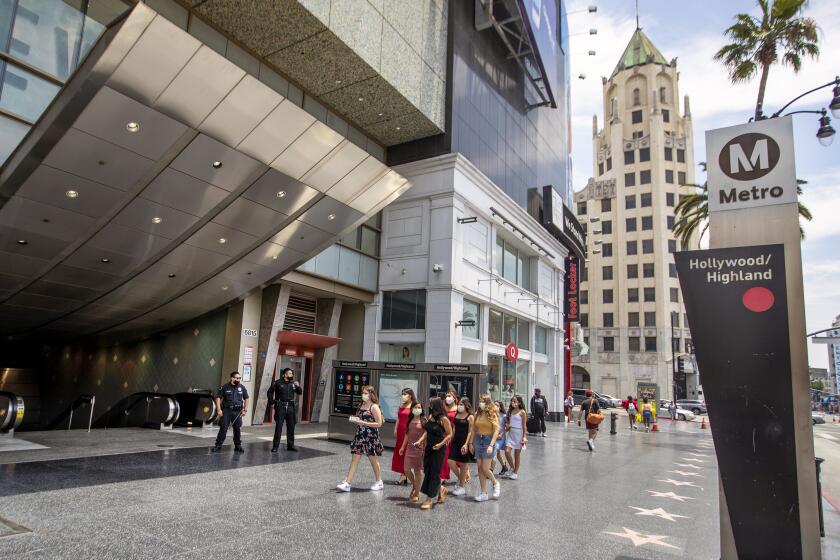Opinion: L.A.’s half-empty, crime-ridden Metro trains don’t have to stay that way

- Share via
It’s no secret that the pandemic devastated public transit systems across the country, and Los Angeles’ ever-expanding Metro rail system is no exception. With many white-collar employees now working remotely for all or much of the week, ridership on the region’s subway and light-rail lines is still around just two-thirds of its pre-COVID peak. The situation is even worse for systems such as Bay Area Rapid Transit, or BART, which is overly reliant on the office workers and employers who have largely abandoned downtown San Francisco.
But therein lies the key to Metro’s long-term recovery. Originally conceived in the 1970s as a BART-like system primarily serving downtown employers and commuters, Metro rail has since sprawled to the far reaches of Los Angeles County. At the same time, downtown L.A. has become a residential and entertainment destination, not just an employment center. As a result, the current rail network serves a variety of riders heading to many destinations for a range of reasons. That helps explain why, for the first time since the federal government began keeping records two decades ago, Metro trains are now serving more people than their Bay Area counterparts.
To survive and thrive over the long run, however, Metro needs to build on these strengths and abandon business as usual. The best recipe for long-term success — one we’ve seen in thriving cities across the world from Milan to Busan — is to allow more apartment buildings, offices and mixed-use projects to be built within walking distance of the stations. Beyond keeping Metro rail viable, more such walkable neighborhoods will provide environmental, economic and quality-of-life benefits for their residents.
Commuters have abandoned large swaths of a Los Angeles Metro train system plagued by crime and the scourge of drugs.
Yet it’s local governments, not Metro, that control what’s built around the rail stations. And too often, city leaders are captured by well-heeled homeowners who reflexively object to new development, particularly high-density housing.
Even when cities do approve dense development near Metro train stops, they often include so much parking as to make a mockery of the transit-friendly location. Take the office project that the L.A. City Council just approved at Sunset and Wilcox in Hollywood. Sure, it’s a 15-story tower just a short walk from the Red Line. But with enough spaces for 1,179 private automobiles, it’s basically a parking garage with a few offices on top.
L.A. and other local governments should be required to loosen development and zoning restrictions near rail stops, eliminating nitpicky requirements and endless hearings. With the region experiencing a major housing shortfall and sky-high prices that have pushed lower-income residents to other regions and states or, in too many cases, the streets, allowing more dense, accessible housing is a humanitarian need as much as a transit one. With Metro and other transit agencies facing a “fiscal cliff” as federal COVID aid expires and the ridership slump lingers, state leaders could make loosened land-use requirements part of any eventual rescue package.
As Metro seeks to build expensive yet critical additions to its existing rail network, such as the Purple Line extension along Wilshire Boulevard to Westwood and beyond, state leaders could also help the agency save money by giving it master permitting authority over construction and streamlined environmental review, as is done in Paris, Madrid and other successful, transit-rich cities. Otherwise, projects often exceed budgets and blow deadlines due to endless concessions to hyperlocal interests, lawsuits and byzantine bureaucracy. It’s a microcosm of why the United States is now among the worst of the world’s advanced economies when it comes to building large-scale transit projects.
Bass is looking to replace former Councilmember Mike Bonin on Metro’s board. Her choice could be crucial to the future of the troubled transit agency.
Also in the interest of efficiency, Metro should build more bus rapid transit using dedicated lanes instead of new rail routes, especially for outlying communities that are not densely populated enough to justify expensive rail construction. Dedicated bus lanes can move people as quickly as trains at a small fraction of the cost.
To lure riders back in the short term, Metro will have to address the crime and safety concerns of riders, which reflect broader economic and social challenges as well as the dearth of riders. Since lack of housing supply and consequently high rents are the chief cause of homelessness, state and local policymakers can help Metro contribute to the long-term solution by facilitating more apartments near stations, which will have the added benefit of encouraging more ridership.
Four decades after it launched, L.A. Metro rail is facing its biggest challenges. Failure to meet them will mean a downward spiral of decreasing service and disappearing ridership as well as a betrayal of the vision sold to voters. But if more people can live, recreate, shop and work near Metro stations, the system can achieve long-term stability, provide a return on the region’s multibillion-dollar investment and fulfill the promise of rail in Los Angeles.
Ethan N. Elkind directs the climate program at UC Berkeley Law’s Center for Law, Energy and the Environment and is the author of “Railtown: The Fight for the Los Angeles Metro Rail and the Future of the City.”
More to Read
A cure for the common opinion
Get thought-provoking perspectives with our weekly newsletter.
You may occasionally receive promotional content from the Los Angeles Times.












